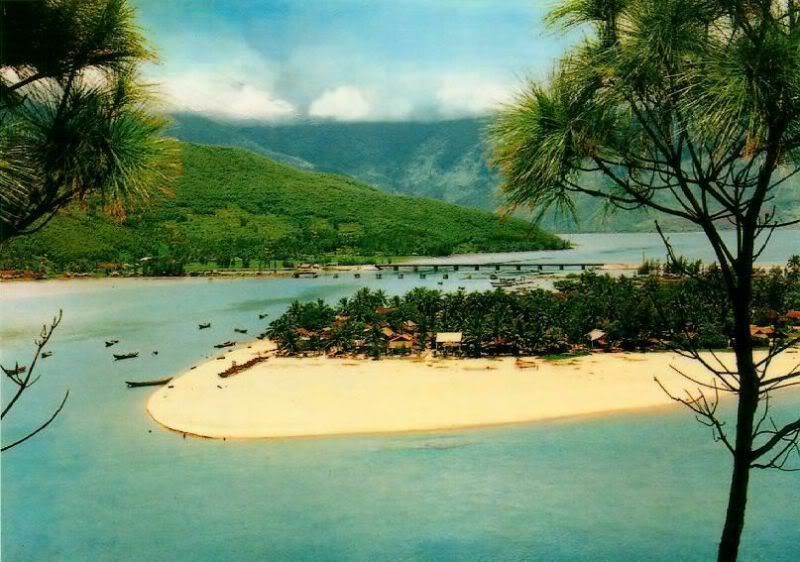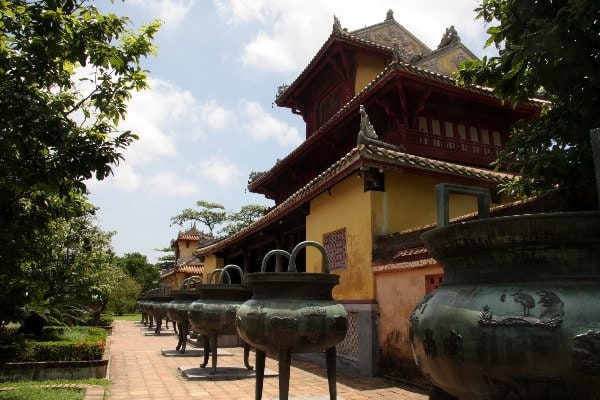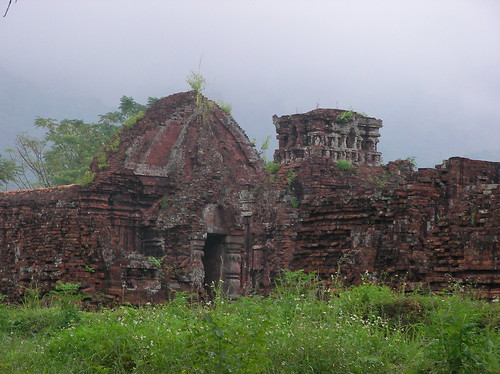The
Nature has awarded Vietnam a fabulous Wonder with grandiose green
tropical jungles, nice & mysterious caves & grottoes, and the
Asia’s oldest limestone mountains.., that is, Phong Nha-Ke Bang National
Park
Geographical Location
Phong Nha - Ke Bang (or
Vườn quốc gia Phong Nha-Kẻ Bàng in Vietnamese) is a huge national park located in
Bo
Trach and Minh Hoa Districts of central Quang Binh Province, in
north-central Vietnam. The National Park is about 500 kilometers south
of the nation's capital, Hanoi. The park was created to protect one of
the world's two largest karst regions with around 300 caves and
grottoes, and the ecosystem of limestone forest of the Annamite Range.
The core zone of this national park covers 85,754 hectares, which are
divided into three zones, a "strictly protected zone" (64,894 km²), an
"ecological recovery zone" (17,449 km²), and an "administrative service
zone" (3,411 km²). The plateau is probably one of the finest and most
distinctive examples of a complex karst landform in Southeast Asia.
Climate
Like the North-central (or Bac
Trung Bo) in general and Quang Binh Province in particular, the climate
in this national park is tropical, hot, and humid. The annual mean
temperature is 23 to 25°C, with a maximum of 41°C in the summer and a
minimum of 6°C in the winter. Annual rainfall is 2,000 mm to 2,500 mm,
and 88% of the rainfall is from July to December. With more than 160
rainy days per year, no month is without rain. Mean annual relative
humidity is 84%. The typical tropical climate has helped build up a pure atmosphere of the green ecological environment, ideal for any visitor.
Formation History
Formation: The
Phong Nha–Ke Bang karst has evolved since the Paleozoic (some 400
million years ago) and so is the oldest major karst area in Asia. Like
much of Vietnam, it has been subject to extensive tectonic changes, thus
the limestones of Phong Nha are inter-bedded with a number of other
rocks. There is also strong evidence that sulphurous solution and
hydrothermal action have played an important role in shaping the
broad-scale landscape and the caves.Historical name: The
park deprives it name from Phong Nha cave, the most beautiful of all,
containing many fascinating rock formations, and Ke Bang forest.
One has explained that Phong Nha means “Wind and teeth” based on Chinese
transcription, which expresses the blowing wind inside the cave and
teeth-like rough stalagtites. There have been several other ways of
explanation, yet none is more popular than this.
People now flock to
this National Park for contemplating the UNESCO-recognized world
natural beauty, and also for directly witnessing the fabulous rock
formations inside the caves.
A nature-gifted magnificient landscape: 7 best in one
Phong
Nha-Ke Bang park takes pride in the assessment of containing “7 best
things” as a result of a National Science Conference held in Quang Binh
in April, 1997. They are:
1. The longest water cave
2. The highest and widest cave mouth
3. The widest and most beautiful sand & rock bank
4. The most beautiful underground lake
5. The most magnificient and miraculous stalactite
6. The nation’s longest underground river (around 13,969 m)
7. The nicest and widest dry cave
It
is certain that when one goes on a bout around this beautifully
miraculous zone, he may be surprised and feel that he were lost in
somewhere in the Heaven where he does not want to leave at all! So now
let’s take a round trip to try this fabulous feeling!
Let’s tour!
Rivers & Streams
Phong
Nha is such a beautiful landscape that you may have to hold your breath
on contemplating. Here are the charming Son and Chay Rivers, (the two
longest underground ones in the Phong Nha-Ke Bang), gently flowing in
the middle of the two sides’ reed and green bamboo rows. Most
of the caves here have been shaped by those two rivers. The Son River
flows into the mouth of the Phong Nha cave, which is the only point
where it emerges in around 20 kilometeres. Also, there are more than ten
spectacular streams, springs and waterfalls in Phong Nha-Ke Bang area,
namely Gió waterfall, Madame Loan & Chài waterfall, Mọc stream
erupting from a limestone mount range, and Trạ Ang stream. Far
far away can you see the enchanting pure Bong Lai Lake and Chai
waterfall, adorned with a number of dark violet “bằng lăng” flower
baskets blooming in the warm weather. Some tourists ever uttered: “Wow!
Heaven!” since the scenery is so much romantic and marvellous!
The
Park also contains two dozens of mighty limestone mountains with over
1,000 m in height. Some of the most noteworthy peaks are the Co Rilata
Peak with the height of 1,128 m and the Co Preu Peak with a height of
1,213 m. Non-karstic topograhical area accounts for a low percentage,
distributing mainly in outer circle of limestone in the north, northeast
and southeast of this national park. The height of these summits varies
from 500-1000 m with the deep divisions. The grandiosity and uniqueness of the limestone mountain ranges that only can be found in Phong Nha-Ke Bang is of great attraction to tourists.
It’s now time to explore the zone in its rich Flora-Fauna composition. The Ke Bang primary jungles have been home
to 98 families, 256 genera and 381 species of vertebrates, many of
which are listed in the Vietnam and World's Red Book. If you are bold
enough, you can go further into jungles to see by yourself these lively rare animals, Gecko,
Macaque, White-cheeked Crested Gibbon, Hatinh and Black Lagur, Mainland
Serow, Giant Muntjac, Saola, Bear, Bull, and so forth. Watching them closely and directly is somehow thrilling but extremely interesting!
Besides, for those fond of plants, it’s good news that the tropical jungles have a
huge number of tropical trees, grass, bush on limestone rocks and soil
mounts, sindora trees, rattan and bamboo forest, and the nation’s
greatest Calocedrus rupestris. It has
140 families, 427 genera, and 751 species of vascular plants, of which
36 species are listed in the Vietnam's Red Data Book.
Penetrating to a distance of 1,500 m inside Phong Nha Cave, tourists may go from surprise to surprise! Phong Nha - Kẻ Bàng is
also
named “Kingdom of Caves”. Up to now, there are more than 300 caves that
have been discovered, and still continuously shaped by the Chay River.
The Son River flows into the mouth of the cave and keeps flowing
underground, where it is referred to as the Nam Aki River. The main
Phong Nha cave comprises 14 chambers, connected by an underwater river
that runs for 1.5km. Notable caves and grottos of Phong Nha are Phong
Nha Cave (
Hang Phong Nha), Dark Grotto (
Hang Tối), E Grotto (
Hang E), Cha An Grotto (
Hang Chà An), Thung Grotto (
Hang Thung), En Grotto (
Hang Én), Khe Tien Grotto (
Hang Khe Tiên), Khe Ry Grotto (
Hang Khe Ry), and Khe Thi Grotto (
Hang Khe Thi).
The most famous one is Phong Nha cave, which has been considered as
“First-ranking Cave Wonder” for its world’s most beautiful stalactites
and longest rivers by the Brishtish Royal Geography Association. Sitting
on your boat along the Son River into the Cave, listening to the wind
whistling as if in a Cathedral, you may be unable to return! As you get
farther into the cave, the more illusory the stalactites and stalagmites
look as they glitter when bright light is shone on them. Here
you can contemplate the splendid landscape of the ancient huge
teeth-like stalactites falling and stalagmites roughly rising. The
stalactite brilliant light stretches throughout the cave as a beautiful
silk full of colors.
Each of the cave contains its own mysterious and
miraculous secrets of the eternal dark Caves, stimulating and absorbing
tourists to come and discover by themselves!
World recognition
Honorably
recognized to be the World Heritage Site by UNESCO in 2003, Phong
Nha-Ke Bang National Park has brought in a great pride for not only the
locals but also all the Vietnamese. The reason for being recognized is
that it meets criteria viii “outstanding geological, geomorphical, and
geographical values”. This year, Phong Nha-Ke Bang National
Park has submitted to UNESCO second time for recognition as a world
natural heritage for biodiversity.
Besides, in the “7 New
World Natural Wonders” voting, Phong Nha-Ke Bang has been one among 3
sites of Vietnam (together with Ha Long Bay and Fanxipan) to be in the
candidate list. Though the final results are to be given at the end of
the year, in the announcement of the New7Wonders at 6 a.m on February 22nd,
2008 (Vietnamese time), Phong Nha-Ke Bang was ranked second (to Ha Long
Bay) in the list of 77 world natural wonders. Ever since the
significant moment of being on this list, the National Park has
attracted a much greater number of visitors from all over the world!
How to get there?
If
you are in Hanoi, the best way to get to the site is by train, the
Thong Nhat one. After arrival at Dong Hoi station, you could travel by
road or by sea. Both are easy to use, yet the latter could bring you the
realistic understanding of a riverside life.
Tourist activities
- Tour for expedition of caves and grottos in boats and with professional cave expedition means.
- Ecotourism, discovering the flora and fauna in this national park in the Ke Bang Forest.
- Mountain
climbing: There are extreme sloping mountains here with a height of
over 1,000m, which is a real challenge for adventurous climbers.
- vietnam-beauty.com















 The
imperial city of Thang Long is situated in the historic center of
Hanoi. Thang Long was actually the historic name of Hanoi before
colonialism. It is composed of two sites; the first one is a complex
comprising different nice buildings and the citadel with its famous
tower. The other one, situated very close (cross the road), is an
archeological park where buildings and antiquities are getting
excavated. This place is interesting to see how people excavate things
and how deep in the ground it can be. The imperial city has more than
ten centuries of history and several dynasties used to live in. It was
also welcoming ritual ceremonies.
The
imperial city of Thang Long is situated in the historic center of
Hanoi. Thang Long was actually the historic name of Hanoi before
colonialism. It is composed of two sites; the first one is a complex
comprising different nice buildings and the citadel with its famous
tower. The other one, situated very close (cross the road), is an
archeological park where buildings and antiquities are getting
excavated. This place is interesting to see how people excavate things
and how deep in the ground it can be. The imperial city has more than
ten centuries of history and several dynasties used to live in. It was
also welcoming ritual ceremonies. In
2008, I visited Hanoi with no expectation as my prime interest was the
famous Ha Long Bay, but I also made a sightseeing tour to many places;
apart from the beautiful Hoan Kiem pond in the city center, I also
visited many temples such as Van Mieu, and Ho Chi Minh Mausoleum and its
museum. I thought I had seen all the must see of Hanoi which in my
opinion except Ho Chi Minh’s, the historic sites in Hanoi were just fine
with no significant or unique.
In
2008, I visited Hanoi with no expectation as my prime interest was the
famous Ha Long Bay, but I also made a sightseeing tour to many places;
apart from the beautiful Hoan Kiem pond in the city center, I also
visited many temples such as Van Mieu, and Ho Chi Minh Mausoleum and its
museum. I thought I had seen all the must see of Hanoi which in my
opinion except Ho Chi Minh’s, the historic sites in Hanoi were just fine
with no significant or unique. 







